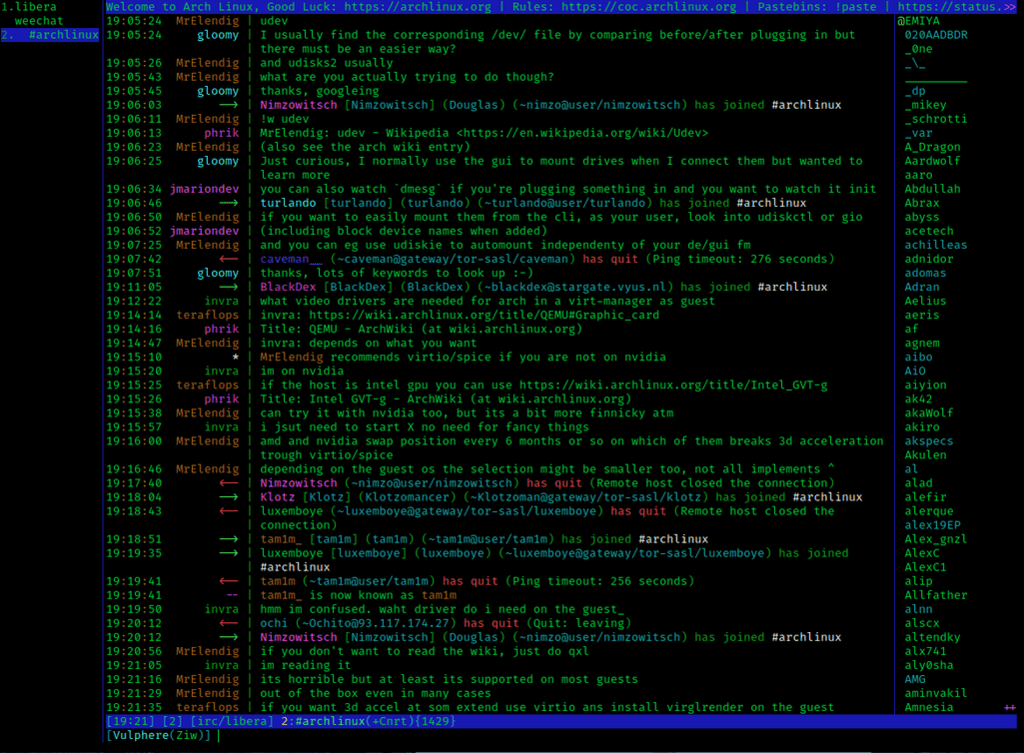Internet relay chat (IRC) might not have been the first tool to allow web users to have real-time discussions with each other. But by introducing the concept of open chat rooms to the world, it contributed hugely to the evolution of the internet.
We’ve talked on this blog about some earlier online chat technologies: Talkomatic, which was the very first chat program; and CB Simulator, which was the first platform that allowed the general public to create a chat group. But both of these tools were limited in terms of who could sign up.
Talkomatic was a part of the PLATO system, which was a closed network of mainframes used primarily in academia and the government. CB Simulator was a commercial product, but it only worked on special hardware and was never a huge success in the marketplace.
When IRC debuted in the late 1980s, it turned these walled-garden models on its head. With IRC, anyone could get connected. You only needed a client program running on your PC and an internet connection.
Let’s delve further into what made IRC unique.
The role of servers and networks
IRC came about in 1988 in Finland. Jarkko Oikarinen, a student at the University of Oulu, was spending his summer administering a server at the university — which included a public bulletin board system.
BBSs were tools used mostly by hobbyists as discussion areas and for sharing files. The systems also had a chat component, but it worked more like a mailbox. You’d send messages only once or twice a day, due the cost and hassle of dialing in.
In Oikarinen’s words, his objective was to make the university’s BBS more functional by injecting real-time communication features.
“The purpose was to allow USENET News-kind of discussion and groups there in addition to real-time discussions and other BBS-related stuff,” he said.
As part of Oikarinen’s efforts, he set up the first IRC server: which would host conversations and allow administrators special privileges (like kicking out someone for bad behavior). After one of his friends convinced the University of Oulu to allow people outside the university to connect, another server was configured — and when the two servers were linked, the first IRC network was born.
Not long after, Oikarinen introduced the IRC concept to computer scientists at MIT in the first recorded instance of a transatlantic online chat. As more American users got onboard with IRC, the number of servers (and networks) grew quickly.
A unique feature: IRC channels
The internet in the late 80s and early 90s was much less complex than it is today. IRC used a client-server model that was quite basic.
To access IRC, a user would first install client software onto their PC. (Desktop clients existed for all the major operating systems.) Next, they would establish a connection between their client and an IRC server. Via the client, they could send messages or instructions through the server software.
While it might have made sense to keep conversations within a server that were very specific (e.g., curriculum discussions on the University of Oulu’s original IRC), what allowed IRC to serve as a true multi-user chat system were networks. In order to have a private chat with another specific person, IRC users didn’t have to connect their clients to the same server, but the servers to which they had dialed in needed to be part of the same network.
This is where the “R” in the definition of IRC comes from: your messages would get relayed across different servers until the messages reached the recipient.
Networks allowed for what may be IRC’s most exciting feature: network-wide channels, or chat rooms organized around a specific topic. They could have anywhere from two to hundreds of users, and were the first widely available “spaces” for group communication.
As a precursor to online discussion forums, channels had their own rules and guidelines, enforced by moderators called channel operators, or chanops. In an open environment, chanops were needed to enforce rules, keep conversations on topic, and kick out bad actors.
Extending channel functionality with bots and scripts
At the same time, individual people and chanops weren’t the only users of IRC channels. Scripts and bots could also be configured to engage within IRC.
Scripts are client add-ons that allow repetitive tasks to be automated. IRC servers are controlled with basic commands, and scripts were often used to shorten an IRC command to save users having to type. Bots, as autonomous programs, are more complex: capable of signing on to IRC and interacting with servers and clients.
In the early days of IRC, scripts and bots were used for entertainment: e.g., to troll other users by sending them canned messages. But they have more substantive uses too. One early bot, NickServ, offers an example.
NickServ was created to notify people that their “IRC nick” (what we would today call a username) was in use by someone else on the server. It also had a companion bot, NoteServ, that let people send asynchronous messages directly to a registered NickServ user.
Bots could be configured to enforce chat room rules, or take action against those who were violating them. They could maintain a user’s persistent connection with a server to maintain control over a nickname or channel (yes, you had to stay logged in to claim “ownership”). They could be set to reply (chatbots) or play games like Mafia (gamebots).
What made IRC revolutionary wasn’t just that it allowed humans to communicate with machines at scale. It’s also the fact that IRC’s web service tools were user-designed and -implemented. This was one of the main advantages of IRC: that there was a democratic spirit to it that doesn’t really exist today.
The peak year for IRC was 2005. At that time, there were 4 popular IRC networks (Quakenet, Undernet, IRCnet and EFnet), each of which had more than 100,000 daily active users.
In the place of these IRC networks, we have social networks. But, like the very first chat programs, they’re essentially walled gardens. And they’re purely commercial: they exist primarily for profit.
The history of IRC may be a reminder that the internet really was more fun a few decades ago, when you could hop on a specific channel to meet new people, create a new channel to start a conversation — or launch your own server with your own rules.
Image of WeeChat courtesy Wikipedia.


